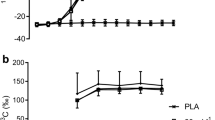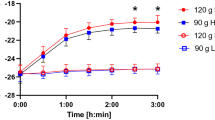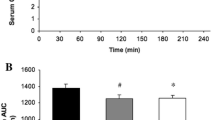Abstract
Previously, we examined the effects of carbohydrate (CHO) ingestion on glucose kinetics during exercise at 70% of maximum O2 uptake (\(\dot V\)O2,max). Here we repeat those studies in heavier cyclists (n=6 per group) cycling for 3 h at a similar absolute O2 uptake but at a lower (55% of\(\dot V\)O2,max) relative exercise intensity. During exercise, the cyclists were infused with a 2-3H-glucose tracer and ingested U-14C glucoselabelled solutions of either flavoured water (H2O) or 10 g/100 ml glucose polymer, at a rate of 600 ml/h. Two subjects in the H2O trial fatigued after 2.5 h of exercise. Their rates of glucose appearance (R a) declined from 2.9±0.6 to 2.0±0.1 mmol/min (mean ± SEM) and, as their plasma glucose concentration [Glu] declined from 4.7±0.2 to below 3.5±0.2 mM, their rates of glucose oxidation (R ox) and fat oxidation plateaued at 2.7±0.4 and 1.7±0.1 mmol/min respectively. In contrast, all subjects completed the CHO trial. Although CHO ingestion during exercise reduced the final endogenousR a from 3.4±0.6 to 0.9±0.3 mmol/min at the end of exercise, it increased totalR a to 5.5±0.5 mmol/min (P<0.05). A higher totalR a with CHO ingestion raised [Glu] from 4.3±0.3 to 5.3±0.1 mM and acceleratedR ox from 3.5±0.2 to 5.9±0.2 mmol/min after 180 min of exercise (P<0.05). The increased contribution to total energy production from glucose oxidation (34±1 vs. 20±1 %) decreased energy production from fat oxidation from 51±2 to 40±5% (P=0.08) and produced patterns of glucose, muscle glycogen (plus lactate) and fat utilisation similar to those during exercise at 70% of (\(\dot V\)O2,max). Thus, CHO ingestion is necessary to sustain even prolonged, low to moderate intensity exercise and when ingested, it suppresses the higher relative rates of fat oxidation usually observed at exercise intensities less than 60% of\(\dot V\)O2,max.
Similar content being viewed by others
References
Bergstrom JL, Hermansen L, Hultman E, Saltin B (1967) Diet, muscle glycogen and physical performance. Acta Physiol Scand 71:140–150
Bosch AN, Dennis SC, Noakes TD (1993) Influence of carbohydrate loading on fuel substrate turnover and oxidation during prolonged exercise. J Appl Physiol 74:1921–1927
Bosch AN, Dennis SC, Noakes TD (1993) Underestimation of substrate oxidation during exercise due to failure to account for bicarbonate kinetics. Letters to the editor (reply). J Appl Physiol 75:2342–2343
Bosch AN, Dennis SC, Noakes TD (1994) Influence of carbohydrate ingestion on fuel substrate turnover and oxidation during prolonged exercise. J Appl Physiol 76:2364–2374
Brooks GA, Mercier J (1994). Balance of carbohydrate and lipid utilisation during exercise: the “crossover” concept. J Appl Physiol 76:2253–2261
Coggan AR, Habash DL, Mendenhall LA, Swanson SC, Kien CL (1993) Isotopic estimation of CO2 production during exercise before and after endurance training. J Appl Physiol 75:70–75
Consolazio CR, Johnson RE, Pecora LT (1963) Physiological measurements of metabolic functions in man. McGraw-Hill, New York, pp 72–87
Costill DL, Bennet A, Branham G, Eddy D (1973) Glucose ingestion at rest and during prolonged exercise. J Appl Physiol 34:764–769
Coyle EF, Hagberg JM, Hurley BF, Martin WH, Ehsani AA, Holloszy JO (1983) Carbohydrate feeding during prolonged strenuous exercise can delay fatigue. J Appl Physiol 55:230–235
Coyle EF, Coggan AR, Hemmert MKA, Ivy JL (1986) Muscle glycogen utilisation during prolonged strenuous exercise when fed carbohydrate. J Appl Physiol 61:165–172
Deuster PA, Chrousos GP, Luger A, DeBolt JE, Bernier LL, Trostman VH, Kyle SB, Montegomery LC, Loriaux DL (1989) Hormonal and metabolic responses of untrained, moderately trained, and highly trained men to three exercise intensities. Metabolism 38:141–148
Gollnick PD (1985) Metabolism of substrate: energy substrate metabolism during exercise as modified by training. Fed Proc 44:353–357
Hawley JA, Hopkins G (1995) Aerobic glycolitic and lipolytic systems: A new paradigm with implications for endurance and ultra-endurance events. Sports Medicine 4:240–250
Hawley JA, Noakes TD (1992) Peak power output predicts maximal oxygen uptake and performance time in trained cyclists. Eur J Appl Physiol 65:79–83
Hawley JA, Dennis SC, Noakes TD (1992) Oxidation of carbohydrate ingested during prolonged endurance exercise. Sports Med 14:27–42
Hawley JA, Bosch AN, Weltan SM, Dennis SC, Noakes TD (1994) Glucose kinetics during prolonged exercise in euglycaemic and hyperglycaemic subjects. Pflügers Arch 426:378–386
Jones NL, Cambell EJM (1982) Clinical exercise testing. Saunders, London, pp 235–239
Karlsson J, Saltin B (1971) Diet, muscle glycogen, and endurance performance. J Appl Physiol 31:203–206
Katz J (1982) Importance of sites of tracer administration and sampling in turnover studies. Federation Proc 41:123–128
Koivisto VA (1986) The physiology of marathon running. Sci Prog 70:109–127
Lehmann M, Wybitul K, Spori U, Keul J (1982) Catecholamines, cardiocirculatory, and metabolic response during graduated and continuously increasing exercise. Int Arch Occup Environ Health 50:261–271
McGuire EAH, Helderman JH, Tobin JD, Andres R, Berman M (1976) Effects of arterial versus venous sampling on analysis of glucose kinetics in man. J Appl Physiol 41:565–573
Radziuk J, Norwich KH, Vranic M (1978) Experimental validation of measurements of glucose turnover in non steady state. Am J Physiol 234:E84-E93
Rauch LHG, Rodger IM, Wilson GR, Belonje JD, Dennis SC, Noakes TD, Hawley JA (1995) The effects of carbohydrate loading on muscle glycogen content and cycling performance. Int J Sport Nutr 5:25–36
Scherrer S, Heldemann B, Kupfer A, Reubi F, Bercher J (1978) Hepatic metabolism of amino pyrine in patients with chronic renal failure. Clin Sci Mol Med 54:133–140
Spencer MK, Yan Z, Katz A (1992) Effect of low glycogen on carbohydrate and energy metabolism in human muscle during exercise. Am J Physiol 262:C975-C979
Steele R (1959) Influence of glucose loading and of injected insulin on hepatic glucose output. Ann NY Acad Sci 82:420–430
Author information
Authors and Affiliations
Rights and permissions
About this article
Cite this article
Rauch, L.H.G., Bosch, A.N., Noakes, T.D. et al. Fuel utilisation during prolonged low-to-moderate intensity exercise when ingesting water or carbohydrate. Pflugers Arch. 430, 971–977 (1995). https://doi.org/10.1007/BF01837411
Received:
Revised:
Accepted:
Issue Date:
DOI: https://doi.org/10.1007/BF01837411




